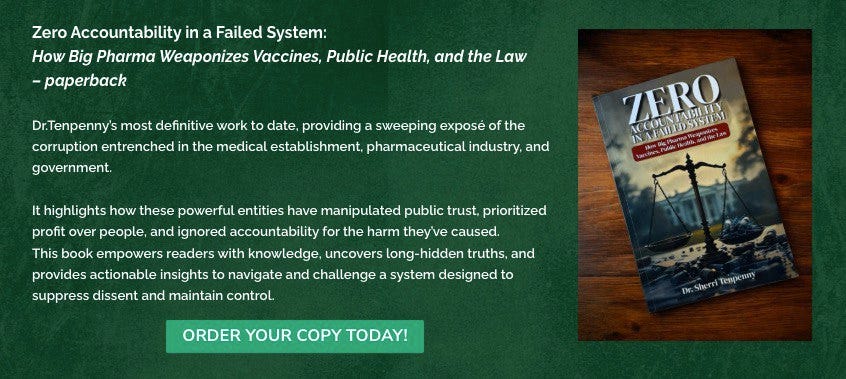Making Money on the Problem AND the Solution

It has been a very busy week.
I have been in Texas on a mini-book tour, doing in-studio interviews with Alex Jones, Mike Adams, Alec Zech, and Owen Shroyer. All of these events were to showcase my new book, Zero Accountability in a Failed System: How Big Pharma Weaponizes Vaccines, Public Health, and the Law.
Here’s a bit from the book, to give you a taste of what it’s about: (excerpted from ZERO ACCOUNTABILITY in a Failed System)
+++++++++++++++++++++++++++++++++++++
Pharmaceutical, chemical, and agribusiness companies, along with Big Gas and Big Oil, are not truly separate industries. Instead, they operate more like “sister enterprises,” collaborating for mutual benefit, power, and profit. These industries act as synergists, generating massive wealth by creating drugs to address health problems that often stem from their own products. The intricate connection between these industry giants is both deliberate and masterful.
Here’s one intricate example:
The pharmaceutical company AstraZeneca was created through a merger between UK-based Zeneca, a major producer of industrial chemicals and pesticides, and the Swedish drug giant Astra. In 1997, the year before the merger, Zeneca reported total sales of $8.62 billion, with 49% stemming from pesticides and industrial chemicals and another 49% from pharmaceuticals – primarily cancer treatments. Notably, Zeneca’s pesticide acetochlor was linked to several cancers, including lung, skin (melanoma), pancreatic, and breast. The pesticide was licensed in the US through a co-registration agreement with Monsanto.
In 1994, the Environmental Working Group highlighted that multiple herbicides in the triazine family – atrazine, simazine, and cyanazine – had been repeatedly shown in studies involving female rats to cause breast cancer, with evidence suggesting a similar increased risk in women.
The primary manufacturer of atrazine and simazine is Syngenta, a company formed through the merger of Novartis’ agribusiness division and Zeneca’s agrochemical division.
Interestingly, two drugs are produced by Novartis Oncology – Femara, used to treat breast cancer, and Zometa, used to treat breast cancer that has spread (metastasized) to the bones.
In 1985, when still owned by Imperial Chemical Industries, Zeneca founded National Breast Cancer Awareness Month, a campaign that has since become synonymous with pink ribbons and events like “Run for the Cure.” After the merger that created AstraZeneca, the company continued its significant role in shaping the campaign, funding materials such as leaflets, posters, and ribbons. AstraZeneca also held the original patent for tamoxifen, a drug widely prescribed to prevent breast cancer recurrence.
However, tamoxifen is also a known carcinogen. It has been linked to an increased risk of two types of cancer: endometrial cancer, which develops in the lining of the uterus, and uterine sarcoma, which arises in the uterine muscle. According to the NIH and the Cancer Information Network, women taking tamoxifen are twice as likely to develop uterine cancer compared to those taking a placebo. Despite these risks, the drug remains a cornerstone of breast cancer treatment, underscoring the complexities and contradictions of the industry’s approach to health care.
Adriamycin, a drug commonly used to treat endometrial cancer, is manufactured by Pharmacia, Inc., a former owner of Monsanto, the company behind Agent Orange. Similarly, Syngenta’s Bt 176™ technology was first introduced to genetically modify (GM) corn and has since been applied to modify thirteen different fruits and vegetables. Despite the widespread presence of GM foods, independent research into their potential health risks remains sparse.
Animals, however, appear to sense something humans overlook. During their annual migration, geese in Illinois avoided consuming rows of soybeans planted with Monsanto’s GM soya. In 1999, The Washington Post reported that rodents refused to eat GM tomatoes. When researchers force-fed the tomatoes to the animals via stomach tubes, 17% died within two weeks. The instinctive behavior of animals might serve as a warning we should heed.
These examples underscore the complex and troubling relationship between agribusiness and pharmaceuticals. The same industries that produce chemicals linked to the development of cancer also manufacture the drugs used to treat the very diseases their products may have caused.
++++++++++++
Get your copy today!! Repair your health!!
Repair your health!!